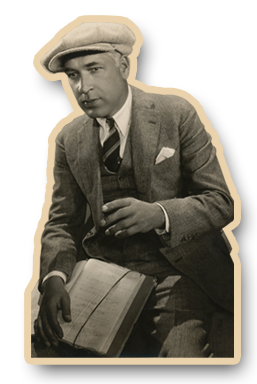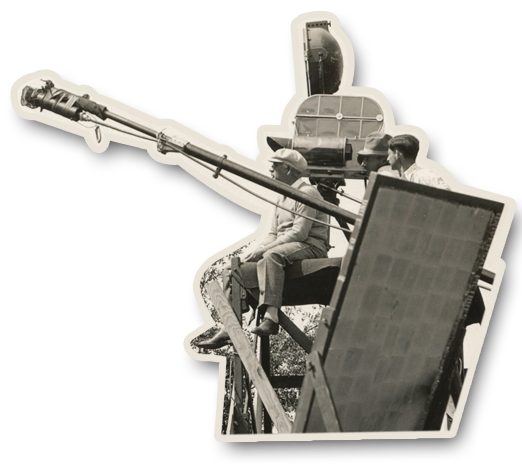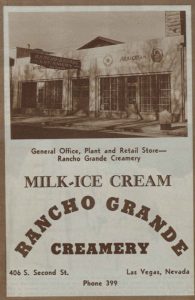It was during the year in 1930 when Edwin began scouting a location for his new venture. He had heard about this big ranch in Nevada which would be ideal for the culmination of his business plan to get into the ranching business as his film career was beginning to wind down with the advent of talking pictures.
On January 1, 1931 Edwin signed a lease agreement for more than 150 acres of roaming ranch acreage in Nevada at what would later become Las Vegas. At the time, the ranch and homestead was called “The Stewart Ranch” after Archibald Stewart obtained the land from Octavius Gass, a miner who originally settled on the land from the remains of an old Mormon mission and fort from around 1873.
Helen J Stewart, wife of Archibald and nick named “The First Lady of Las Vegas” owned nearly 3000 acres of ranch land in the 1880’s, in the middle of nowhere. Her family ranch was the only thing here. It was called the “Stewart Ranch.” There was a natural spring near their ranch to supply the much needed water. Her family would sometimes host weary travelers who were making their way down the Old Spanish Trail, or Mormon Trail, between Salt Lake City and southern California. Then there were rumors of the railroad coming to Las Vegas as they were equally interested in finding a resting place where there was water, and to refuel their steam powered engines. Stewart was able to sell a large portion of her ranch to the man who was hoping to bring, and did eventually bring, the railroad through Las Vegas. After she sold the ranch to the railroad in 1902 it was then usually referred to as the “Old Ranch” or “Las Vegas Ranch”, though a few locals still called it the “Stewart Ranch”. The railroad was called the San Pedro, Los Angeles and Salt Lake City Railroad at that time. In Las Vegas they created a smaller company called the Las Vegas Land and Water Co to run local operations here. The LVLWCo leased out the Old Ranch to private residents who could continue to run it as a ranch, dairy and meat market to supply the city’s new residents with these necessary supplies. The railroad coming through here and stopping here is what brought people here and what created Las Vegas as a town, a much needed resting point between Salt Lake City and California.
Through his company, Carewe-Moreton Enterprises and The Biltmore Conservation Corp located in the iconic E Clem Wilson Building on the corner of Wilshire Blvd and La Brea, Edwin set out to begin his venture into the ranching, dairy and eventually the garbage reclamation business. It is important to note that the E Clem Wilson building, built in 1929 and where Edwin began this venture in Los Angeles, was at the time an architectural wonder and he was one of its very first tenants. Today, the building is known as The Wilshire/La Brea Building. It was also used as the first Daily Planet location for the first Superman television series.
In December of 1930, Edwin was in full motion with development plans for a $25,000.00 plant on his new ranch to process garbage and manufacture animal feed. Using patented technology called “The Biltmore Process,” he would use a special chemical treatment and steaming process to render the garbage so pure it would be safe for humans. His plans were quite lofty at the time stating that he was developing this technology in Dallas, Texas with 10 steam cookers and was planning to roll it out nationally to Syracuse, New York, Portland, Oregon and Petaluma, California.
By July of 1931, Edwin had planted some 150 acres of alfalfa, corn and other grains and had harvested some 197 tons of grains to feed the livestock on the ranch which included cattle, hogs and poultry. It was clear at the time that this was a business venture for Edwin and he had every intent of making profits from this venture. Inclusive of the cattle and hogs, Edwin also planned to add various types of poultry to include, chickens, turkeys, quail and Hungarian pheasants. He was also adding the business of frogs to the ranch as well noting that he had planted some 50,000 frogs to the acreage and that he had planned to add frog legs to his venture. In fact, it was during one visit to the ranch that Mary Akin commented that she “looked forward to going frog hunting one evening.”
In correspondences between Edwin and the LVLWCo, he was making attempts to extend his lease from five years to 15 years, noting that he would need a longer lease to make his venture the success that he had envisioned. During these correspondences, he had also made requests to make changes to the buildings on the property and also try to convince the LVLWco to build a dam on nearby waters to provide him with more water to grow his crops. At the time, Edwin noted that he wanted to remove certain buildings and renovate the original adobe home so that his son-in-law, LeRoy Mason, could live there and be in charge of the ranch. LeRoy Mason was also an actor who had worked with Edwin on several silent films. LeRoy was married to Rita Carewe, a daughter from his first marriage before he married Mary Akin, his second wife.
It was during a visit to his new ranch, renamed “Rancho Grande” in February of 1931 that while riding one of his horses, he was bucked from the horse and landed in the middle of the creek and was up to his neck in water and mud, commenting that his tailor would have much work to do in order to clean his fine riding clothes. The horse, a fine white steed can be viewed in the Gallery of photos on this website. At the time he also noted that his long standing friendship with Will Rogers and Tom Mix stemmed from before they were all famous while working together on the famous Miller Brothers 101 Ranch near Ponca City, Oklahoma noting that “ranching runs through my veins.” This would have been sometime around the turn of the century when Edwin was roughly 18 years of age. Ironically, the 101 Ranch was founded in 1893 by Colonel George Washington Miller, a veteran of the Confederate Army and was quite famous for developing a Wild West show featuring regional Indians with Buffalo Bill Cody, Pawnee Bill, Tex Ritter, Tom Mix, Will Rogers and Apache Indian Geronimo.
In March of 1931, Edwin had purchased the business interests of The Las Vegas Creamery at 406 South Second Street in Las Vegas by his new venture at Rancho Grande and was renamed The Rancho Grande Creamery in the grand scheme of production from the ranch to his new creamery in Las Vegas.
By December of 1932, shortly after Carol Carewe was born, his third and last child with actress/wife Mary Akin, Edwin had charged his brother Wallace with managing all the work to be done at the homestead and in conjunction with the Ranch Manager, LeRoy Mason.
In August of 1933, everything changed for Edwin when he declared bankruptcy in a Los Angeles court. Likely, this was a culmination of events in his life starting with the federal charges and indictment for tax evasion in April of 1932 as well as the developing Great Depression. His last film, “Are We Civilized” was produced in 1934 and was his first and only attempt to transition from silent films to talking films.
It is clear from this new discovery that Edwin had carefully planned to enter the ranching and garbage reclamation business as a means of continuing his legacy through his long career in the silent film movie business as both an actor and producer/director.



May I have permission to use the photo of the Rancho Grande Creamery in a privately published family history of my father, Bert Whitney? He worked at the creamery in 1941. If possible, I would love to have a copy with a higher resolution. Thank you!
Joy W Stubbs (familyhistorywriting@gmail.com)
Hello Joy, Yes, you can use the photo for your personal family history. I will reach out to you directly in regards to the photo in question.
Hi mate
I was out metal detecting and I found a rancho-Grande creamery pen.
I was wondering if you have some history on it.
Cheers
Greetings, Thanks for the message and discovery. The pen you found was likely a marketing item from the time when Edwin took over the creamery and rebranded it. I wonder what condition it is in? Are you able to share a photo?
Hi there
Its condition is good.
I can email a photo if u what.
Hi there again.
What do u think of it?
Can u give me an idea how it made it’s way to australia?
And how rare it is?
Cheers
Hello again, the pen certainly is rare and the first one we have seen. As to how it made its way to Australia, that’s a good question. If only the pen could talk, the story it might tell.